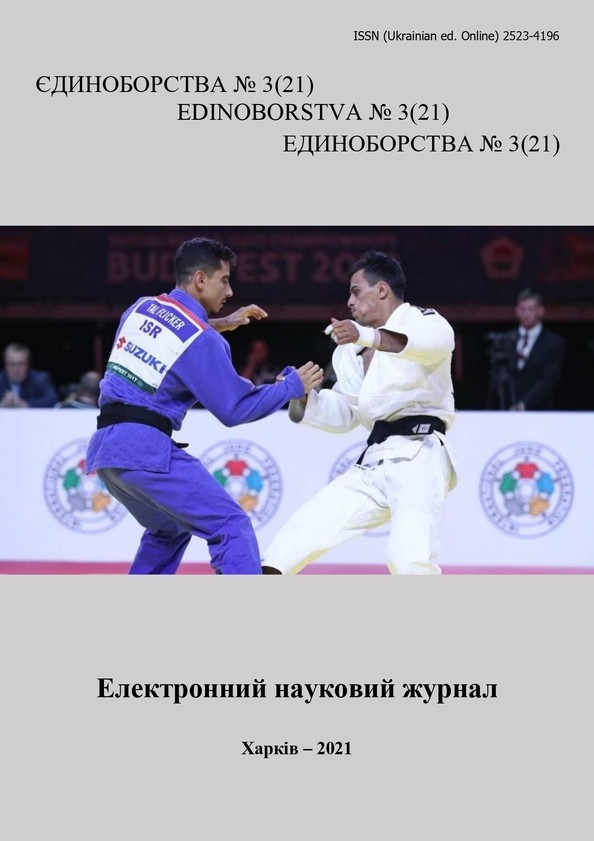The dynamics of physical fitness of 5 grade pupils under the influence of outdoor games with elements of martial arts
DOI:
https://doi.org/10.15391/ed.2021-3.03Keywords:
physical culture, martial arts, students, lesson, means, elementsAbstract
Purpose: to determine the
dynamics of physical fitness of 5 grade pupils under the influence of outdoor games with elements
of martial arts. Material and methods. The research was carried out in Kharkov, on the basis of a
comprehensive school of I-III levels No 118. The study involved 40 students of 5t grade
(20 experimental and 20 control groups). In the educational process, which was developed on the
basis of the curriculum in physical culture for general educational institutions of grades 5-9
(approved by order of the Ministry of Education and Science of October 23, 2017 No 1407, we
included outdoor games with elements of martial arts). During the research, the following methods
were used: theoretical analysis and generalization of literary sources, Internet data, generalization
of theoretical and practical experience of specialists in the field of physical culture and martial
arts, pedagogical research, methods of mathematical statistics. Results: the analysis of the results
obtained indicates that the indices of physical fitness are better in the experimental group than in
the control group. The results of the arithmetic mean indicators when performing a 30-meter run in
the experimental group were 6,45±0,1, in the control group 6,46±0,11 s; shuttle run test 4×9 m (s)
in the experimental group – 11,74±0,16, in the control group - 11.83 ± 0.14; in the test, the long
jump from the spot (cm), 146,55±3,05 and 146,55±3,05; indicators of the test performance long
jump with a run (cm) in the experimental group are within 245-310 cm, in the control group 240-
320; when throwing a small ball at a distance (m) in the experimental group – 22,45±1,12 and the
control group – 20,15±1,05; indicators of pupils in the experimental and control groups in the test
of raising the body in sitting for 30 seconds 23,4±0,82 and 20,65±0,85. Conclusions. Modern trends in physical education in general educational institutions require the teacher to search for
new means and methods to expand the motor experience of students. This can be achieved through
the targeted use of specialized outdoor games with elements of martial arts. After the pedagogical
experiment, the level of competence of students in the experimental group is higher than that of the
control group. The high level of competence in the experimental group ranges from 15 to 80 %,
sufficient - from 20 to 50 % and average - from 15 to 35; in the control group, students
predominantly have sufficient from 30 to 40 and average from 25 to 60 % and high from 15 to
60 %. The results of the indices of the coefficients of variation of the experimental and control
groups are stable in terms of the general population in the tests: running 30 m (sec) – 7,42 and
7,79; shuttle run 4 × 9 m (s) 6,37 and 5,41; standing long jump (cm) 9,29 and 8,86; long jump with
a run (cm) 6.77 and 7.87, moderately stable: throwing a small ball at a distance (m) 22,36 and
23,29; raising the body in a sitting position in 30 seconds (number of times) and 18,6.
References
Бойченко, Н.В., & Тропин, Ю.Н. (2016). Эффективность применения специализированных подвижных игр в подготовке юных дзюдоистов. Фізична культура, спорт та здоров’я: стан і перспективи в умовах сучасного українського державотворення в контексті 25-річчя Незалежності України, 110-113.
Бордюгов, Е.А., & Григорьев, О.А. (2019). Развитие силовых способностей юных дзюдоистов средствами подвижных игр. Культура физическая и здоровье современной молодежи, 133-135.
Голенкова, Ю.В., & Скригін, А.В. (2015). Вплив засобів східних єдиноборств на розвиток прудкості у школярів середніх класів. Теорія та методика фізичного виховання, (2), 10-14.
Горбачев, А.И., & Горбачева, О.А. (2019). Повышение эффективности уроков физической культуры старшеклассников с использованием элементов самбо. Наука-2020, (1 (26)), 93-97.
Єрьоменко, Е.А. (2019). Навчальна програма з фізичної культури для загальноосвітніх навчальних закладів. Варіативний модуль «Хортинг» (профільний рівень, 10–11 класи).
Єрьоменко, Е.А. (2020). Хортинг для старшокласників. Навчально-методичний посібник. Київ, 229 с.
Киэлевяйнен, Л.М. (2016). К вопросу о реализации самбо в образовательных организациях. Т877 Туризм и образование: исследования и проекты: материалы Всероссийской, 24, 243.
Коваленко, І.М., & Ратов, А.М. (2011). Виховання швидкісно-силових здібностей молодших школярів засобами рухливих ігор з елементами одноборств. Вісник Чернігівського національного педагогічного університету, Т. 86, 87-90.
Лукин, С.А., & Табаков, С.Е. (2019). Концепция преподавания предмета «Физическая культура» с использованием выбранного вида спорта в общеобразовательной школе на примере самбо. ББК 75.715 И88, 24.
Масенко, Л.В. (2016). Формування рухових умінь учнів початкової школи в процесі ігрової діяльності з елементами єдиноборств (Автореф.дис. … канд.пед.н.). Київ, Україна. Навчальна програма з фізичної культури для загальноосвітніх навчальних закладів 5–9 класи (затверджена наказом МОН від 23.10.2017 № 1407.
Палічук, Ю.І., Вілігорський, О.М., & Мартинів, О.М. (2019). Застосування рухливих ігор з метою відбору школярів до занять боротьбою на початковому етап підготовки. Єдиноборства № 4(14), 72-80.
Руденко М.М., Кошляк М.А., Дуброва С.В., Коломоєць Г.А., & Деревянко В.В. (2020). Методика викладання дзюдо в закладах загальної середньої освіти. Методичний посібник. «Букрек», Київ-Чернівці.
Чистякова, М.О., & Шишкін, О.П. (2019). Впровадження спортивних одноборств у навчальну програму з фізичного виховання для загальноосвітніх навчальних закладів. Секція Природничих наук, 118.













